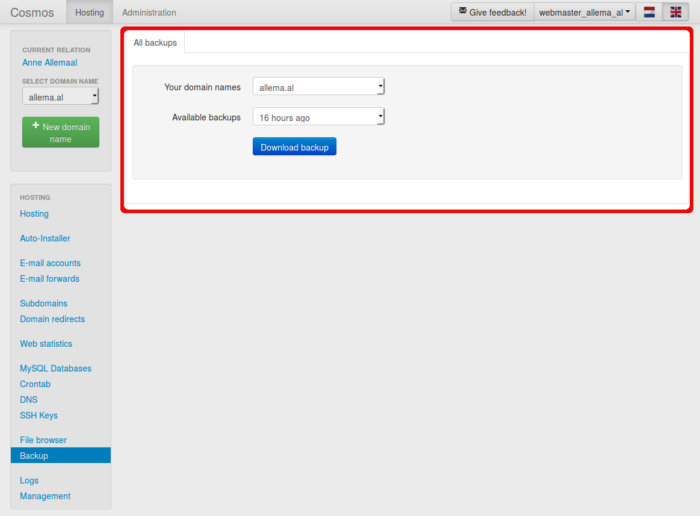Backups
Greenhost maintains backups for all sites hosted on our Shared Hosting platform. You can download backups for the hosting files and databases from the Service Centre. Where to find the fileserver backups and database backups is outlined below.
Contents
File server backups
Backups of the files in your hosting packages are made on a daily basis. The backups are offered per domain name in the Service Centre.
Backup intervals
Backups are made overnight and are usually available in the Service Centre the following morning. The backups are made and kept for every 24 hours until 10 days in the past, thereafter with bigger intervals from a week until a month, up to 2 months in the past.
File server backups in the Service Centre
Log into the Service Centre with your administrator account. Under the 'Hosting' tab, select the right domain name from the drop down menu and click 'Backups' in the bottom left-hand pane.

Downloading a file server backup
Select the desired domain name from the drop down menu. Then select the desired backup from the other drop down menu. To download the backup click the blue 'Download backup' button. Usually your browser will ask you if you want to open or download the backup.

The backup and its contents
Opening the backup
The backup will be downloaded in '.tar.gz' format. Most modern computers will be able to open it. In the unlikely event that you experience problems when trying to open the downloaded backup, then you could consider downloading this program to open the backup.
Contents of the backup
The contents of the backup are:
- the webroots of the domain name (the 'DEFAULT' folder)
- all subdomains that were created via the Service Centre
- all manually placed folders and files within the domain folder
Check the backup before maintenance
We are committed to frequently making backups and making them available to you. Before performing maintenance, we do advise to check if the intended backup meets your expectations. If the latter is not the case, then you can make a fresh backup by downloading the current file server contents. By downloading and checking the intended backup before performing major updates or other maintenance, you can avoid disappointment and additional work in the case that the expected backup turns out to be non-existent, incomplete or damaged.
Database backups
Backups of the MySQL databases are made on a daily basis. The backups are offered per database in the Service Centre.
Backup intervals
Backups are made overnight and are usually available in the Service Centre the following morning. The backups are made and kept for every 24 hours until 12 days in the past, thereafter with bigger intervals from a week until a month, up to 2 months in the past.
Database backups in the Service Centre
Log into the Service Centre with your administrator credentials. Under the 'Hosting' tab, select the right domain name from the drop down menu and click 'MySQL Databases' in the bottom left-hand pane. Then click the sub tab 'Backups'.

Downloading a database backup
Select the desired backup from the drop down menu on the right of the database which you would like to download. To download the backup click the blue download button next to the drop down menu. Usually your browser will ask you if you want to open or download the backup.

The backup and its contents
Opening the backup
The backup will be downloaded in '.sql.gz' format. Most modern computers will be able to open it. In the unlikely event that you experience problems when trying to open the downloaded backup, then you could consider downloading this program to open the backup.
Contents of the backup
The backup contains the full compressed contents of the respective database.
Check the backup before maintenance
We are committed to frequently making backups and making them available to you. Before performing maintenance, we do advise to check if the intended backup meets your expectations. If the latter is not the case, then you can make a fresh backup by downloading the current database. By downloading and checking the intended backup before performing major updates or other maintenance, you can avoid disappointment and additional work in the case that the expected backup turns out to be non-existent, incomplete or damaged.